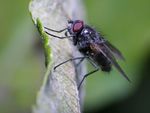Difference between revisions of "Musca spp."
Jump to navigation
Jump to search
| (19 intermediate revisions by 3 users not shown) | |||
| Line 1: | Line 1: | ||
| − | + | [[Image:Muscidae.jpg|right|thumb|150px|Muscidae sp. - Copyright Thomas Bresson]] | |
| − | |||
| − | |||
| − | |||
| − | |||
| − | | | ||
| − | |||
| − | |||
| − | | | ||
| − | | | ||
| − | |||
| − | |||
| − | |||
| − | |||
| − | + | *Also known as 'house' and 'face' flies | |
| − | |||
| − | + | *Includes ''Musca domestica'' the house fly and ''Musca autumnalis'' the face fly | |
| − | + | *Found in temperate regions | |
| − | + | *The house fly is present both inside and outside of buildings | |
| − | The fly is | ||
| − | + | *The face fly is one of the most numerous flies which annoy cattle | |
| − | + | **Attracted to the head and upper parts of the body | |
| − | |||
| − | |||
| − | |||
| − | + | ==Recognition== | |
| + | *7.5mm long | ||
| − | + | *Sponge-like labellum mouthparts | |
| − | |||
| − | + | *Grey thorax with longitudinal stripes | |
| − | |||
| − | + | *Yellow abdomen with a single black stripe | |
| − | |||
| − | |||
| − | |||
| − | + | ==Life Cycle== | |
| + | *Eggs laid in rotting manure, hatch and pass through pupal and larval stages before emerging | ||
| − | + | *Eggs hatch within 12 hours of being deposited | |
| + | *Life cycle takes '''12 days''' | ||
| + | |||
| + | *Flies may overwinter as adults | ||
| + | |||
| + | |||
| + | ==Pathogenesis== | ||
| + | *Production losses | ||
| + | **Reduced weight gain | ||
| + | **Reduced milk yield | ||
| + | **Fly worry | ||
| + | |||
| + | *Disease transmission | ||
| + | **Viruses | ||
| + | ***E.g. Coxsackie, enteroviruses, poliomyelitis | ||
| + | **Bacteria | ||
| + | ***E.g. [[Bacillus species#Bacillus anthracis|Anthrax]], [[Escherichia coli|''E.coli'']], [[Salmonella|''Salmonella'']], [[Shigella|''Shigella'']], [[Moraxella bovis|New Forest Eye Disease]] | ||
| + | **Helminths | ||
| + | ***E.g. Intermediate hosts for [[Parasitic skin infections - Pathology#Helminths|''Habronema'']] in horses, some poultry tapeworms, [[Parafilaria spp.|''Parafiliaria'']] and [[Cattle#Other Cattle Nematodes|''Thelazia'']] in cattle | ||
| + | |||
| + | *Feeds on secretions from the eyes, nose and mouth as well as blood left in wounds by other flies | ||
| + | |||
| + | |||
| + | ==Control== | ||
| + | *Fly control in breeding and resting sites (to reduce the source) | ||
| + | **Breeding sites | ||
| + | ***Good sanitation | ||
| + | ***Collect dung in heaps | ||
| + | ***Spray surface of heaps with insecticide to kill surviving adults and larvae | ||
| + | ***Biological control | ||
| + | **Resting sites | ||
| + | ***Spray inside and outsides of buildings with insecticide | ||
| + | |||
| + | *Fly control on the host | ||
| + | **Wide range of products available | ||
| + | **Nil or short withdrawal period needed for milking animals or animals going for slaughter | ||
[[Category:Nuisance_Flies]] | [[Category:Nuisance_Flies]] | ||
| − | + | [[Category:To_Do_-_Max]] | |
| − | [[Category: | ||
Revision as of 20:48, 15 July 2010
- Also known as 'house' and 'face' flies
- Includes Musca domestica the house fly and Musca autumnalis the face fly
- Found in temperate regions
- The house fly is present both inside and outside of buildings
- The face fly is one of the most numerous flies which annoy cattle
- Attracted to the head and upper parts of the body
Recognition
- 7.5mm long
- Sponge-like labellum mouthparts
- Grey thorax with longitudinal stripes
- Yellow abdomen with a single black stripe
Life Cycle
- Eggs laid in rotting manure, hatch and pass through pupal and larval stages before emerging
- Eggs hatch within 12 hours of being deposited
- Life cycle takes 12 days
- Flies may overwinter as adults
Pathogenesis
- Production losses
- Reduced weight gain
- Reduced milk yield
- Fly worry
- Disease transmission
- Viruses
- E.g. Coxsackie, enteroviruses, poliomyelitis
- Bacteria
- Helminths
- E.g. Intermediate hosts for Habronema in horses, some poultry tapeworms, Parafiliaria and Thelazia in cattle
- Viruses
- Feeds on secretions from the eyes, nose and mouth as well as blood left in wounds by other flies
Control
- Fly control in breeding and resting sites (to reduce the source)
- Breeding sites
- Good sanitation
- Collect dung in heaps
- Spray surface of heaps with insecticide to kill surviving adults and larvae
- Biological control
- Resting sites
- Spray inside and outsides of buildings with insecticide
- Breeding sites
- Fly control on the host
- Wide range of products available
- Nil or short withdrawal period needed for milking animals or animals going for slaughter
